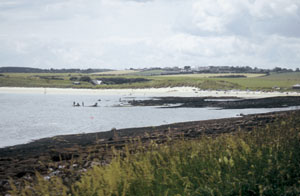 |
These marks offer some tremendous sport, when weather conditions allow, for species like cod, wrasse, pollack and coalfish.
Northumberland is a beautiful county and the area surrounding Newton Point is one of the finest examples of the diverse habitat available to sea anglers. The bay is a sheltered strand of sand where a family can relax, partaking of the pleasures that only a British beach can provide. On weekdays the seafront is quiet and you will have the place to yourself. At the weekend, however, the bay buzzes with day-trippers taking advantage of any spells of good weather. The north side of the bay is skirted by a series of rock ledges topped off with grassy banks, which conceals a dirt track leading around the point to
Burradon Rocks
Newton
Newton Skeers
The rocky skeers skirting the north side of the bay can produce fish at any stage of the tide, although sport peaks at high water and the last two hours of the ebb. To enjoy the best fishing it’s worth visiting the area at low water during a spring tide and noting where the main concentrations of rocky snags are situated. There are numerous spots capable of producing a mixture of codling and ballan wrasse during the summer and very large cod in the winter. On a good northerly swell these marks are sheltered and are fished even when the sea is quite rough. In these conditions the two-hour period either side of low water generally gives the best sport, with fresh or frozen peeler crabs the most effective baits.
Lobster Carrs
At low water Newton Point is divided in two by a deep gully with high rocks on either side. The southern point is known as ‘Lobster Carrs’ where the shoreline is fringed with a veritable jungle of weed beds stretching out to sea, seemingly forever. The rocks are a superb cod and wrasse hotspot where fish to 5lb are landed in good numbers. Most of the cod are taken by casting a peeler crab bait 70 yards to the far edge of the kelp beds. Shorter casts will produce ballan wrasse, and again peeler crabs will be the top baits. When you hook a fish, try to bring it to the surface quickly before it dives into the weed beds, and then reel like mad.
Pern Carrs
The northern side of the gully is known as ‘Pern Carrs’ and is by far the most popular mark at Newton. The main skeers are only accessible for fishing approximately three hours either side of low water. The north corner of rocks, which merges into the Football Hole, is fishable at any stage of the tide. This is an ideal spot to fish during those warm summer evenings when the sea is flat calm. Try to arrive around about mid-tide as the rocky skeers are just emerging, and start fishing the back rocks. Move to the point if bites are slow and vary your casting distance, as many of the fish will be taken at very close range. Ballan wrasse in particular can be hooked only a few yards out when they on the feed.
Football Hole
The south side of the Football Hole is surrounded by low grass-covered cliffs and is a brilliant high-water mark. To the north the cliffs drop away to dunes and a sheltered beach, which gives easy access to the rock edges. Sport can be brilliant with codling, coalies, pollack, ballan wrasse and flounders, plus the occasional bass. In the winter months when easterly winds are pounding the shoreline, these marks will be on top form producing cod to double figures. Lugworms cocktailed with clams, razorfish or frozen crabs will account for most of the fish. In the summer, fresh or frozen crabs take some beating.
Snook Point
Snook Point is a long pier-like formation of weed-covered rocks that starts to appear about approximately three hours after high water. As the tide drops away it can be seen stretching a great distance out to the sea. There are numerous productive marks on both sides of the point and tactics dictate that you keep on the move, following the tide out and then back in. It’s always tempting to assume that the end rocks will be the hotspot, but you could be walking straight past the best marks. It is well worth having a cast into areas where the weed tips are just starting to show, bearing in mind it is sensible to use a rotten bottom system to reduce tackle losses.
TACKLE SHOPS
Amble Angling Centre, Newburgh Street, Amble. Tel: 01665 711200.
Jobson’s Of Alnwick, Tower Showroom, Alnwick. Tel: 01665 602135.
TSF Top Tips 1
If you can’t get hold of any fresh or frozen peeler crabs in the winter, try using a whole squid instead.
TSF Top Tips 2
If you want to target the wrasse, make sure you use a hooklength of no less than 30lb breaking strain to combat their sharp teeth!





